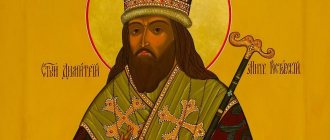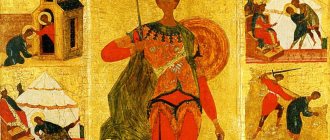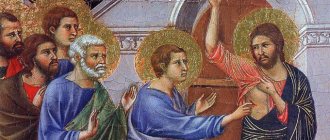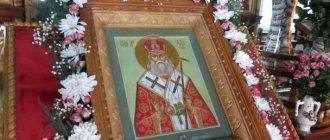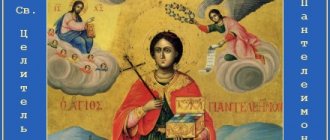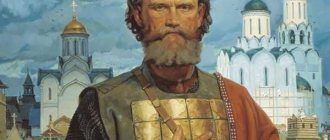Childhood
Orthodox saint Dmitry of Rostov was born in the winter of 1651 in the village of Makarovo, located near Kyiv. They named him Daniel. His family was very pious, the boy grew up as a deeply religious Christian. In 1662, his parents moved to Kyiv, and he entered the Kiev-Mohyla College to study. Here he successfully studied Latin and Greek, as well as a number of classical sciences. In 1668, quiet and in poor health, Daniel became a monk at the Cyril Monastery and received the name Dmitry. He underwent monastic obedience until 1675.
Prayers
Troparion, tone 8
Orthodoxy to the zealot, and schism to the eradicator, / Russian healer, and new prayer book to God, / with your writings you have made you whole, / spiritual priest, blessed Demetrius, / pray ́ Christ God // our souls will be saved.
Kontakion, tone 8
The Russian star rose from Kiev,/ and through Novgrad Seversky reached Rostov,/ but illuminated this entire country with teachings and miracles,/ let us please the golden-talking teacher Demetrius,/ for all wrote, even for instruction, / that he might win everyone, like Paul, Christ, // and will save our souls through orthodoxy.
Preacher of the Word of God
In 1669, Dmitry Rostovsky, whose biography is full of various events, was ordained a hierodeacon. In 1975, Bishop Lazar Baranovich summoned him to Chernigov and, having ordained him as a hieromonk, appointed him as a preacher at the Assumption Cathedral. From here Father Dmitry traveled to Slutsk and Vilna, where he worked hard for the glory of God. Soon he gained the reputation of a very talented preacher, and he was often invited by worldly and spiritual authorities. After the death of his friend, the founder of the Slutsk Monastery, monk Skachkevich, he returned to his homeland - to Little Russia in Baturino.
Abbess and the beginning of life's work
In Little Russia, Saint Dmitry of Rostov settled in a monastery in Baturino. However, the Bishop of Chernigov soon drew attention to him. In 1681, the 30-year-old preacher became abbot of the Maksanovsky monastery, and after some time of the Baturinsky monastery. Father Dmitry stayed in this position for only a short time. In 1683 he moved to the Kiev Pechersk Lavra. Here, in 1684, the saint began the main work of his life - the compilation of the “Chets-Menya”. After some time, he was appointed rector of the Baturinsky Monastery for the second time. But in 1692 he moved to Kyiv again. Then he was successively appointed abbot of the Glukhov, Kirillov and Eletsky (Chernigov) monasteries. In 1700, he was summoned to Moscow, where he first met with Peter the Great, and was appointed Metropolitan of Rostov. The dedication took place on March 23, 1701.
Metropolitan of Rostov
In 1703, Dmitry Rostovsky, whose biography was closely connected with this parish until his death, arrived at a new place of service. Here he faced many difficulties, the main of which was the interference of secular authorities in the affairs of the parish. Shortly before the appointment of Father Dmitry, the Monastic Order was recreated in the city, managing church property and supervising the monks and almshouses. The saint in Rostov was also very unpleasantly struck by the rudeness and ignorance of not only the common people, but also the ministers of the Church. The priests did not reverence the saints at all, treated the poor with contempt, divulged the secret of confession, etc. Seeing such a disorder, Father Dmitry zealously set about correcting the state of affairs. He gave instructions, explained what the duty of a priest meant, and gave sermons to the people.
One of his main concerns was a school for the children of Church ministers and the poor. Education here was completely free. In the school opened by Metropolitan Dmitry, as in Kyiv, Greek and Latin were taught and theatrical performances were shown. The first graduates left its walls in 1706. Unfortunately, the school was closed that spring.
On October 28, 1709, Father Dmitry Rostovsky died. He was buried in the cathedral church of Rostov, next to his predecessor, Saint Joasaph. According to the will of the Metropolitan, drafts of his unfinished books were placed in the coffin. Tsarina Paraskeva Fedorovna herself, the widowed wife of Tsar Ivan, brother of Peter the Great, arrived at the saint’s funeral.
early life
Saint Demetrius of Rostov (name in Baptism - Daniel) was born in the town of Makaryev (located near the city of Kyiv), in the family of the military centurion Tuptala Savva Grigorievich, in December 1651.
Daniel's parents were distinguished by their firmness of faith and piety. From an early age, they instilled in their son respect for God's law, devotion to the Church and the Fatherland.
Due to his father’s frequent absences related to military duty, his mother played the main role in Daniel’s upbringing. Subsequently, he repeatedly recalled her as a virtuous daughter of the Church.
Wanting to give their son a decent education, his parents enrolled him in the Kiev Fraternal School (founded through the efforts of Metropolitan Peter Mogila, this school was famous throughout the area; subsequently, the Theological Academy was formed on its basis).
During the learning process, Daniil showed extraordinary abilities. Thanks to his innate abilities, diligence, and determination, he more than once became an object of admiration from teachers and administration. In the process of completing the educational course, he mastered several languages (Greek, Latin, Polish, Hebrew), mastered the rules of rhetoric and poetics, and became imbued with the teachings of the God-bearing fathers.
Along with theoretical disciplines, Daniel sought to absorb and assimilate practical skills of life in Christ. He preferred a quiet and silent stay in church, reading edifying literature, and mental prayer to noisy companies and pleasure walks with his peers.
When in 1665 the Polish conquerors, having captured Kiev, set fire to the Brotherhood monastery and school, Daniel was forced to return to his parental home. When he returned, he did not abandon his studies, but with even greater spiritual impulse he devoted himself to self-education.
During this period, he regularly participated in temple services, studied the Books of Scripture, and listened to the instructions of the shepherds. Gradually, with the assistance of God, he turned his heart towards monasticism.
Relics of the Saint
In 1752, they decided to make renovations to the cathedral church. During its execution on September 21, while repairing the floor, the incorrupt body of Father Dmitry was discovered. It was a real miracle. The walls of the burial were damp. The saint's oak coffin and the manuscripts inside had completely decayed. The body of the saint himself, as well as his rosary, miter and sakkos turned out to be incorruptible.
After some time, miraculous healings from many diseases began to occur at the relics of the saint, which was reported to the Synod. By order of the latter, Archimandrite Gabriel of Simonov and Metropolitan of Suzdal Sylvester arrived in Rostov. They witnessed the relics and the healings they performed. On April 29, 1757, Metropolitan Dmitry of Rostov was canonized.
On May 25, 1763, the saint’s relics were transferred to a silver shrine, where they remain to this day. The reliquary was made by order of Empress Catherine the Second, who carried it to the installation site personally, together with the holy fathers.
"Lives of the Saints" by Dmitry Rostovsky
The saint wrote this book over 20 years. The result was a work in 12 volumes. It describes the life, miracles and feats of many great Christian saints. "Cheti-Minea" of St. Dmitry became an edification for all Orthodox Christians who want to follow the path of piety.
The stories in this book are told in order of the months and days within them. Hence their name “menaia” (Greek month). “Cheti” in Church Slavonic means “to read”, “intended for reading”. The “Lives of the Saints” were compiled by Father Dmitry partly from the work of Macarius. At the moment, several Menaia are recognized in the Orthodox Church (hieromonk German Tulumov, Chudovsky, Ionna Milyutin, etc.). However, the Lives of the Saints by Dmitry of Rostov are the most revered and widespread. This book was written in a very literate Church Slavonic language.
Literary heritage
The earliest surviving work of Rostovsky is “The Irrigated Fleece,” which tells about the miraculous image of the Mother of God located in the Chernigov Trinity-Ilyinsky Monastery.
The Metropolitan’s main creation is considered to be “The Lives of the Saints,” or “Cheti-Menaia,” a collection of books that reveal the biographies of Old Testament, Russian, South Slavic and pan-Orthodox saints, as well as their exploits. Work on the work lasted almost 20 years.
View this post on Instagram
A post shared by Orthodox Life (@orthodoxlive) on May 4, 2020 at 12:10pm PDT
Icon of Demetrius of Rostov
Labor resembles a calendar, where for each date there are from 1 to several stories. It contains the lives of John Chrysostom, Nicholas the Pleasant, Demetrius of Thessaloniki and many personalities who influenced religion.
Another important work in Rostovsky’s bibliography is considered to be “The Cell Chronicler,” based on the Bible, the works of European chroniclers and church writers. All samples of the saint’s creativity are available on the ABC of Faith website.
Other books of the saint
Another famous work of the Metropolitan of Rostov is “The Search for the Bryn Faith.” This book was directed against the Old Believers. This work, unlike “Minea,” was not very successful. He, of course, did not convince the Old Believers, but he caused a surge of hatred on their part.
Among other things, Saint Dmitry of Rostov actively collected historical information about his diocese and the country as a whole. For example, he worked on compiling a chronology of the Slavic people. He also wrote such books as “The Irrigated Fleece”, “Discourse on the Image of God and the Likeness in Man”, “Diarias”, “A Brief Martyrology”, “Catalogue of Russian Metropolitans”. Various kinds of prayers and instructions belong to his pen.
Proceedings
Works:
- "Irrigated fleece"
- "On Confession of Sins and Holy Communion"
- “Apology to quench the sadness of a person who is in trouble, persecution and embitterment”
- "Mirror of the Orthodox Confession"
- “Spiritual healing against blasphemous thoughts”
- “Spiritual healing for confusion of thoughts from various books of the fathers”
- “The search for the schismatic Bryn faith”
- "Cheti-Minea" ("Lives of the Saints")
Prayers:
- “Prayer of confession to God from a man who lays the beginning of salvation”
- "Lamentation for the Burial of Christ"
- "A Brief Thoughtful Reflection"
- "Prayers of Fives"
- "Psalter of the Mother of God"
Church of St. Dmitry Rostovsky in Ochakovo
Many saints are revered in Russia. Dmitry Rostovsky, of course, is one of them. Many temples are dedicated to him. For example, there is such a structure in Ochakovo. In 1717, a wooden church was built here and consecrated in honor of the Blessed Virgin Mary. In 1757 the village changed hands. He erected a new stone church next to the wooden one in the name of Metropolitan Dmitry. This church has come down to us almost unchanged. It was built in the beautiful Russian Baroque style. A high bell tower is connected to the temple through the refectory.
History of the Church of St. Dmitry is very rich. In 1812 there was a fire in Ochakovo. At the same time, the old wooden church of the Blessed Virgin Mary burned down in the fire. Ekaterina Naryshkina, who bought the village in the same year, according to tradition, decided to open a new temple in its place, and rebuilt one of her estates into it. The church was consecrated in honor of the Holy Trinity and was presumably assigned to the Church of St. Dmitry.
In 1926, this religious building was closed by decision of the authorities. It is known that in 1933 the Church of Dmitry of Rostov was converted into a grain warehouse and had a completely deplorable appearance. The cross was removed from it, and a five-pointed star was painted on one of the pediments, which was later very difficult to erase.
In 1972, they decided to restore the church. The work lasted about 6 years. In 1992, the Church of Dmitry of Rostov was returned to believers. Those Orthodox Christians who want to visit this ancient church should go to General Dorokhov Street, 17 in Moscow.
Temple of Dmitry of Rostov in the village. Right Chava
This church, also consecrated in honor of Dmitry of Rostov, was built in 1824 in the classicist style. Its dome is crowned with a cylindrical dome. The bell tower built next to it is topped with a beautiful figured spire.
In 1882, the educator Lyutitsky opened a school in this church. It is officially believed that from 1930 to 1990 this temple was also used as a grain warehouse. However, there is also information that grain was never stored in this historical building. Believers recall that in 1954-1962 the church even functioned with minor interruptions (because there were not enough priests).
In 1990, the Church of Dmitry of Rostov in Pravaya Khava was transferred to the diocese, after which it was restored by the parishioners themselves. Inside the temple, the remains of wall paintings, as well as the frame of the iconostasis, were miraculously preserved. Since September 2010, V.V. has been serving as a priest here. Kolyadin. At the moment, this ancient church, among other things, is an object of cultural and historical heritage of the Voronezh region.
Troparion to the Saints of Rostov, tone 4
Holy Wisdom, / teacher of the enlightenment of God to your flock, / multiplying the faith of the Gospel in people, / exemplifying heavenly love on earth, / the people of the country of Rostov and Yaroslavl, who shared salvation, / serving truly God, / and the worthy companions of the apostles appeared in nature, / Leontius the Hieromartyr, Isa aie , Ignatius, Jacob, Theodore / and the Russian goldsmith Demetrius, / pray to Christ God / for the bishops who are your successors on the throne, / for the people who piously honor you, / for our Orthodox country // and for the entire Church of Christ.
Prayer to Dmitry Rostovsky
Dmitry Rostovsky, whose life was righteous, even after death continues to protect believers from various kinds of misfortunes. For example, you can be healed from an illness not only by venerating the relics of this saint. A prayer dedicated to him is also considered miraculous. Its original text can be found in church literature. It sounds something like this:
“Holy Great Martyr of Christ Demetrius. Having presented yourself before the Heavenly King, ask him for forgiveness of our sins and for our deliverance from the all-destructive plague, fire and eternal punishment. Ask for his mercy for our temple and parish, as well as for strengthening us for good deeds pleasing to Jesus Christ. Let us be strong in your prayers and inherit the Kingdom of Heaven, where we will glorify it with the Father and the Holy Spirit.”
Kontakion to the Saints of Rostov, tone 4
Guardian of the New Testament of God with man, / fulfiller of the Gospel commandments, / in good deeds, / holy wisdom, venerable and righteous God-bearing, / the land of Rostov and Yaroslavl / fragrant with prayers, / all things named and unnamed, / revealed and hidden, / coming to the Life-Giving Trinity, / do not depart from us in spirit / and incline Divine mercy to us, / so that with boldness we all bring glory to God in the Highest, / may there be indestructible peace on earth, / and love and goodwill // among all people.
